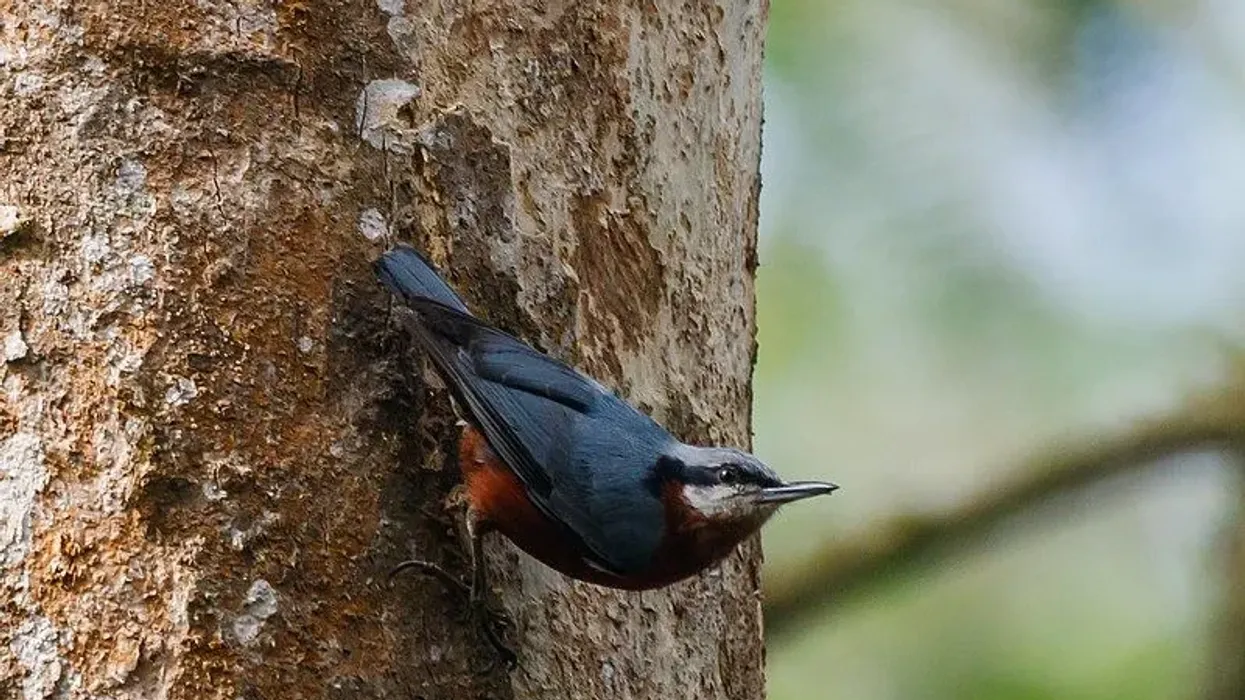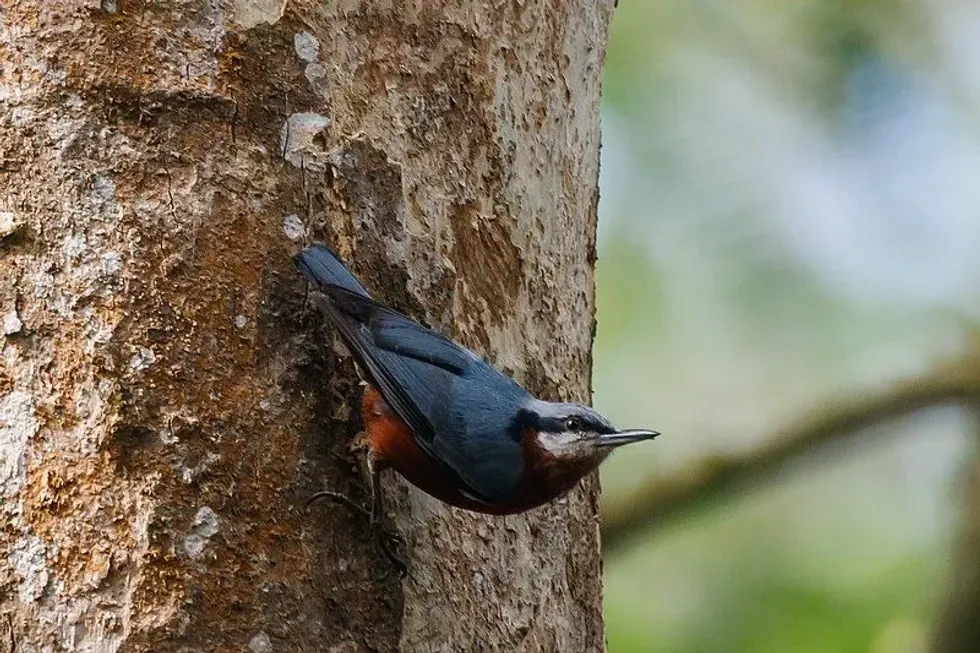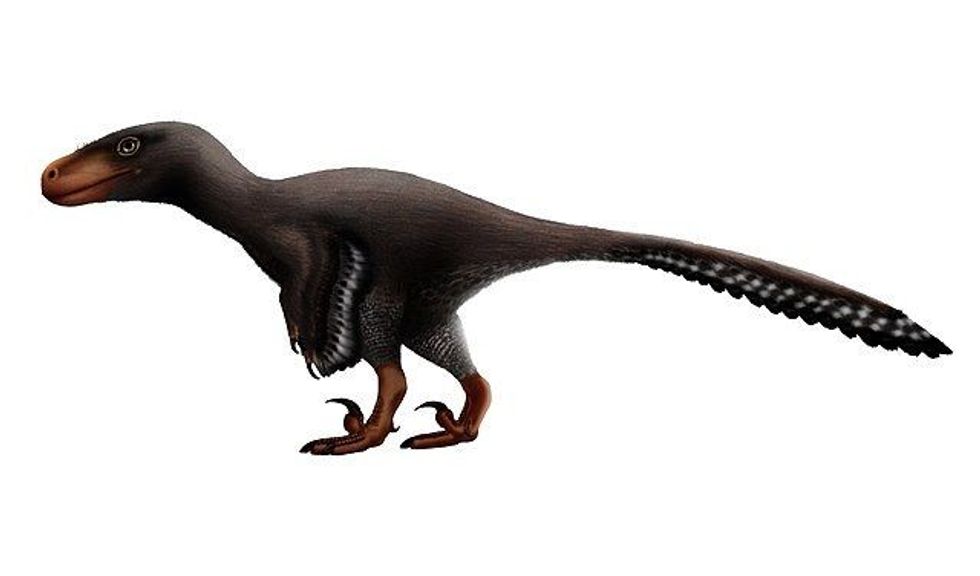Chestnut-bellied nuthatch (Sitta cinnamoventris) is a small active bird that belongs to the Passeriformes order, further classified as a perching bird. It belongs to the Sittidae genus, which is a family of nuthatches and wall-creepers.
The South Asian forms of the bird were once believed to be a subspecies of the Eurasian nuthatch. It is the most common resident of the Himalayas and you can see them on your trip to the mountainous regions of South East Asia.
The chestnut-bellied nuthatch sitta usually flies in small flocks, if not perched alone. The chestnut-bellied nuthatch adaptation is very similar to its closest relative from the Sittidae family, the white-bellied nuthatch.
The two share the closest relation in terms of resemblance, behaviors, and habitat.
However, the white-bellied nuthatch is a native of North America. Often detected by its quick echoing trill, the chestnut-bellied nuthatch (Sitta cinnamoventris) is pretty quirky.
They have powerful claws that help them climb back and forth on tree trunks. Known as Sittelle de Blyth in French, the description was given by a French researcher called Blyth (1842).
Unlike many deciduous birds, the Sittelle de Blyth does not perch on the topmost levels of the canopy. Instead, they are middle dwellers which is why they also forage on the ground for seasonal seeds and fallen fruits.
Find this article about the chestnut-bellied nuthutch bird intriguing? Check out some more fun bird facts about the cockatoo and blue jay.
Chestnut-Bellied Nuthatch Interesting Facts
What type of animal is a chestnut-bellied nuthatch?
The chestnut-bellied nuthatch (Sitta cinnamoventris) is a bird of the Passeriformes order.
What class of animal does a chestnut-bellied nuthatch belong to?
The chestnut-bellied nuthatch (Sitta cinnamoventris) belongs to the class of Aves, which is the class of all birds in the animal kingdom.
How many chestnut-bellied nuthatches are there in the world?
There are four montane subspecies found in total. The Cinnamoventris in the eastern Himalayas, the Almore in the western Himalayas, the Koelzi in north Myanmar, and the Tonkennenis in northern Laos, Thailand, and Vietnam. Since the chestnut-bellied nuthatch sitta's range is extremely wide, it is difficult to number them down to a particular figure.
Where does a chestnut-bellied nuthatch live?
The chestnut-bellied nuthatch sitta species is native to North America, but the current species is mainly found in large areas of East Asian lowland forests. the chestnut-bellied nuthatch habitat lies in the foothills of Uttarakhand, India, Lushai hills in Arunachal Pradesh, India, and Assam Valley also located in India.
These birds are even found on the foothills of the Himalayas in Nepal and Tibet, Bangladesh, Myanmar, Bhutan, all the neighboring countries of India. Chestnut-bellied nuthatch sitta birds further extend to the Chinese territory of Yunnan, Nepal, and central Laos.
What is a chestnut-bellied Nuthatch's habitat?
The natural chestnut-bellied nuthatch sitta is found in subtropical or tropical dry forests, moist lowland forests, and subtropical or tropical moist montanes. Additionally, the chestnut-bellied nuthatch sitta is a resident of shallow wooded areas.
They live in forests, on forest edges, and in open areas where food is available. Apart from their prime locations, the chestnut-bellied nuthatch range from certain areas of Nepal, southern Mexico, Vietnam, Thailand, India, and Central America.
Who do chestnut-bellied nuthatches live with?
The chestnut-bellied nuthatch sitta lives in small flocks of their own species outside the breeding season, and these flocks are almost like a temporary family. During the breeding season, they live in pairs, mostly in mid-levels of forests. A flock of nuthatches is known as a jar.
How long does a chestnut-bellied nuthatch live?
The lifespan of the Sittelle de Blyth spans between two to three years. The longest lifespan of a nuthatch is recorded to be 10 years.
How do they reproduce?
Chestnut-bellied nuthatches lay two to seven eggs and have an incubation period of 11-12 days. The female incubates the eggs, and both parents make the nest out of mud and twigs which is cup-shaped. The breeding season lasts from February to March.
What is their conservation status?
The current range of the chestnut-bellied nuthatch sitta is clearly very wide and there has been no signs of a drastic decline in the last three generations. The chestnut-bellied nuthatch sitta is listed as a species of Least Concern in the IUCN Red List for birds.
Chestnut-Bellied Nuthatch Fun Facts
What do chestnut-bellied nuthatches look like?
The chestnut-bellied nuthatch appearance of the male and female is nearly the same, and the variation changes across regions. The chestnut-bellied nuthatch sitta has a black wing along the length of their eye-line, a shiny crown, a short tail, a pointed needle-like bill, and dark red underparts in the male.
The most contrasting difference between chestnut-bellied nuthatch sitta's appearance in the birds of the eastern and western origin is that the ones of the eastern origin are paler.
Furthermore, the white patch on the under tail separates them from each other. The total height of the bird does not exceed 2 in (5 cm) in length.
How cute are they?
Chestnut-bellied nuthatches are sweet and smart birds that are sure to catch your attention with their liveliness and melodious songs if spotted.
How do they communicate?
Belonging to the Passeriformes order, chestnut-bellied nuthatch sitta birds communicate through short vocal notes commonly referred to as songs.
How big is a chestnut-bellied nuthatch?
The chestnut-bellied nuthatch sitta is one of the smallest nuthatches and is almost three times smaller than the biggest bird in its family.
How fast can a chestnut-bellied nuthatch fly?
They have a short flight range wingspan and cannot fly too fast.
How much does a chestnut-bellied nuthatch weigh?
An average chestnut-bellied nuthatch sitta may weigh around 0.6-0.7 oz (17-20 g) and is almost two times smaller than the biggest member of its species, the brown-headed nuthatch which weighs around 1.3-1.7 oz (36–47 g).
What are the male and female names of the species?
The chestnut-bellied nuthatch male and the chestnut-bellied nuthatch female are both known by this common name.
What would you call a baby chestnut-bellied nuthatch?
Like many other birds of the world, the babies of the chestnut-bellied nuthatch sitta are referred to as nestlings when they are still inside their nests and fledglings when they are freshly out of their nests. A cute name to call them with could be baby nuthatches.
What do they eat?
The chestnut-bellied nuthatch diet is made up of insects, ants, larvae, acorns, and seeds. Since they are tree dwellers, they are prone to be attacked by predators like squirrels and weasels.
Are they poisonous?
Chestnut-bellied nuthatch sitta birds are harmless.
Would they make a good pet?
The chestnut-bellied nuthatch sitta will certainly make a good pet as they are sweet birds that are sure to keep you entertained with their melodious songs.
Did you know...
Chestnut-bellied nuthatches use their loud calls to display their territories and keep away potential opponents from occupying them.
The chestnut-bellied nuthatch sitta combines resin with mud for making their nest.
Unlike most other nuthatches, the adult chestnut-bellied nuthatch sitta does not hoard food. However, the juveniles are known to do so.
The chestnut-bellied nuthatch sitta is the biggest bird among the nuthatches family.
A lot of the subspecies of its genus look strikingly similar with little room for distinction. However, all versions have three colors- blue, white, and brown in common, with little variations of hues.
Do nuthatches eat upside down?
Yes, not only do chestnut-bellied nuthatches sittas eat upside down, but they also mount back and forth on tree trunks in order to catch and eat the insects filled within the gaps. For this reason, they are also known as 'upside-down birds'.
How did nuthatches get their name?
The chestnut-bellied nuthatch sitta collects and shoves its food into the crevices and cracks of tree bark.
After storage, they peck at the collected seed with their sharp beak to break it out from the inside. Their pecking behavior is better observed during the winters than any other season, as it is the time of the year to store and use the collected food.
As most of the birds store and use their food during the winters, winter is the perfect time to observe how nuthatches earned their common name.
Here at Kidadl, we have carefully created lots of interesting family-friendly animal facts for everyone to discover! Learn more about some other birds from our hummingbird facts and vesper sparrow facts for kids from our fact pages.
You can even occupy yourself at home by coloring in one of our free printable Chestnut bellied nuthatch coloring pages.









